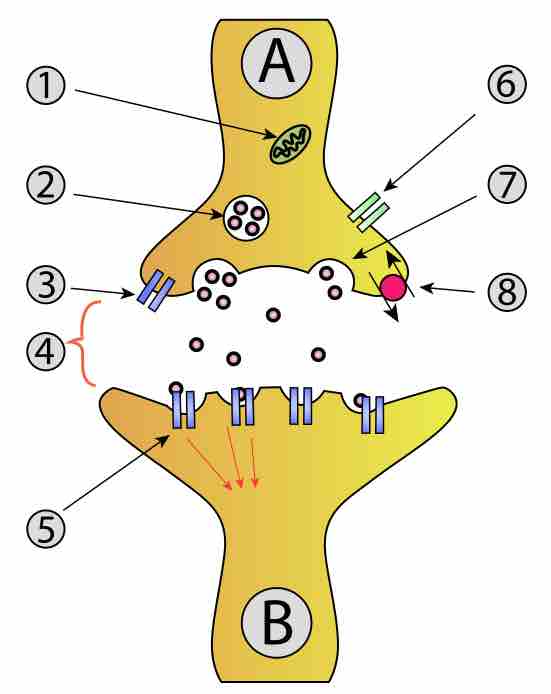The Synapse
In the nervous system, a synapse is a structure that permits a neuron to pass an electrical or chemical signal to an effector cell. Synapses between axon endings of one neuron and a dendrite is called axodendritic synapse. Synapses between 2 axons is called axoaxonal and between 2 dendrites is called dendrodendritic and between dendrites and cell body is somatodendritic.
The neuron conducting impulses towards the synapse is called presynaptic neuron. The neuron transmitting the electrical impulse away from the synapse is called postsynaptic neuron. At a synapse , the presynaptic neuron sends information and postsynaptic neuron receives the information. Most neurons, function as both as presynaptic and postsynaptic neurons.
There are two varieties of synapses: electrical and chemical synapse. In a chemical synapse, the plasma membrane of the signal-passing neuron (the presynaptic neuron) comes into close apposition with the membrane of the target (postsynaptic) cell. Both the presynaptic and postsynaptic sites contain extensive arrays of molecular machinery that link the two membranes together and carry out the signaling process. The presynaptic neuron contains a chemical called a neurotransmitter that is packaged into synaptic vesicles clustered beneath the membrane in the axon terminal. The neurotransmitter is released into and diffuses across the synaptic cleft, where it binds to specific receptors in the membrane on the postsynaptic side of the synapse. Release of neurotransmitters usually follows arrival of an action potential at the synapse, but may also follow graded electrical potentials found in dendrites.
In an electrical synapse, the presynaptic and postsynaptic cell membranes are connected by special channels called gap junctions that are capable of passing electrical current. These gap junctions contain connexion proteins which allow the ions and small molecules to flow directly from one neuron to the next. The neurons are electrically coupled and transmission across these synapses is very rapid. The key feature of electrical synapse is that it provides a simple means of synchronizing activity of all interconnected neurons. These are found in stereotyped movements as in jerky movements of the eye and in hippocampus and amygdala where emotions and memory is processed.

Synapse
A: Neuron (Presynaptic) B: Neuron (Postsynaptic)MitochondriaSynaptic vesicle full of neurotransmitterAutoreceptorSynaptic cleftNeurotransmitter receptorCalcium ChannelFused vesicle releasing neurotransmitterNeurotransmitter re-uptake pump